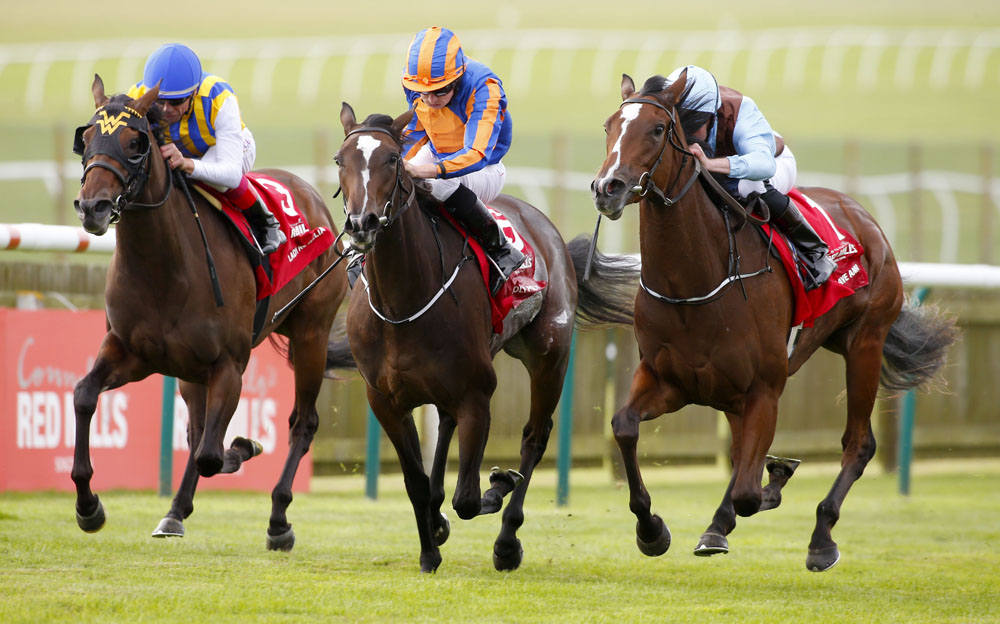By Andrew Caulfield
As Brave Anna and Roly Poly strolled around the pre-parade ring together, it was impossible not to notice the physical similarities between the two, which extend to their facial markings. Perhaps this is hardly surprising because they are bred along similar lines. Whereas the victorious Brave Anna is out of a daughter of Sadler's Wells, Roly Poly–already winner of the G2 Duchess of Cambridge S.–is out of a granddaughter, by Galileo.
Bearing in mind that Sadler's Wells, like Danzig, was a son of Northern Dancer, it is understandable that War Front has been mated to a relatively small number of daughters of the 14-time champion sire. The pairing produces 3 x 3 to Northern Dancer (plus 4 x 5 to Forli). The seven Sadler's Wells mares with racing-age progeny by War Front have 11 foals, of which eight have started. In addition to Brave Anna, Liscanna has produced the year-older Hit It A Bomb, winner of the GI Breeders' Cup Juvenile Turf. Then there's The Brothers War, who was fast enough to win a listed race over six furlongs as a 3-year-old, even though his stoutly-bred dam Moon Queen was a Group 2 winner at around a mile and a half. And Omar Bradley was narrowly beaten over seven furlongs at G3 level in France at two, making it four group performers from eight runners.
This adds to the belief that War Front is destined to enjoy tremendous success with his growing number of progeny out of very accomplished racemares by Galileo–Roly Poly being one of the first.
It is going to be fascinating to see how far Brave Anna stays. Her career already features two disappointing efforts over seven furlongs, but the picture is clouded by the possibility that she may not have been at her fittest for those races. Also, the ground was much slower then than the fast ground she encountered in the Cheveley Park.
Last year, after Hit It A Bomb's Group I victory at Keeneland, I did a bit of research on Liscanna for an article in the Thoroughbred Owner & Breeder. Here's what I wrote:
“Sadler's Wells had 2,259 foals, but how many six-furlong races did they manage to win in Britain and Ireland after the age of two? The answer is a mere four. Victories over seven furlongs were also fairly rare, with just 33 successes compared to 333 over a mile and a quarter, 325 over a mile and a half and 199 over a mile and three-quarters or more. Add in all the victories over intermediate distances and the average works out to a substantial 11.2 furlongs.
“Sadler's Wells owed all of those rare six-furlong wins to fillies, the best of them being the listed-placed Akua'Ba (now the dam of Group 2 winner Akua'da) and Liscanna. Although Liscanna was tried at up to nine furlongs as a 2-year-old, she proved fast enough at three to win the G3 Ballyogan S. over six. It isn't hard to find the source of her speed. Her dam Lahinch was a member of the first crop sired by the dual 2-year-old Group 1 winner Danehill Dancer and she helped put this future champion sire on the map. Lahinch won two races over five furlongs, including a listed race, before ending her first season with a narrow defeat in the G2 Rockfel S. She collected another listed victory at three, this time over seven furlongs. On her final appearance she contested the Prix de l'Abbaye, so she was obviously thought to be very speedy.”
I went on to point out that Liscanna was the only foal Sadler's Wells sired from a Danehill Dancer mare. This takes on greater significance now that Sadler's Wells's imperious son Galileo has sired The Gurkha, Minding and Alice Springs–collectively winners of nine Group 1 races this year–from other Danehill Dancer mares. The fact that Liscanna's dam Lahinch was sired by Danehill Dancer means that Danzig appears in the second and fifth generations of Brave Anna's pedigree. With Nijinsky and Be My Guest also in her fifth generation, Brave Anna has five lines of Northern Dancer–a situation which is by no means unusual these days.
You can get some idea of the quality of Brave Anna's female line from the $425,000 paid by Shadwell for her third dam, the Private Account filly Dublah, as a yearling. Dublah's appeal included the fact that she was a granddaughter of Paint the Town, a Vaguely Noble mare who earned a Timeform rating of 121 while racing at around a mile and a half. Paint The Town in turn was out of Belle de Nuit, a GI Test S. winner who was a half-sister to Evening Out, America's champion juvenile filly of 1953.
Clearly Brave Anna's juvenile ability is nothing new for this family.
Not a subscriber? Click here to sign up for the daily PDF or alerts.






